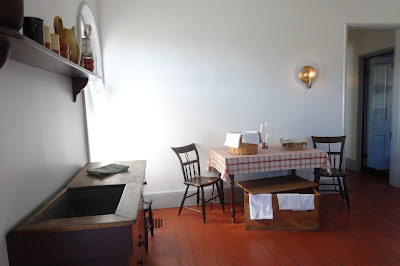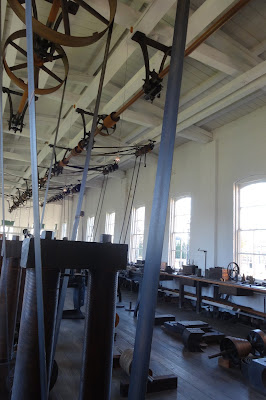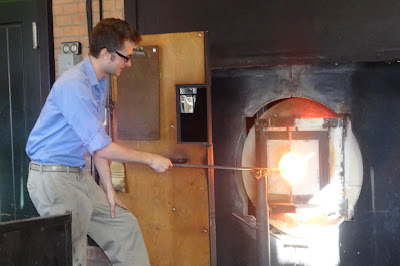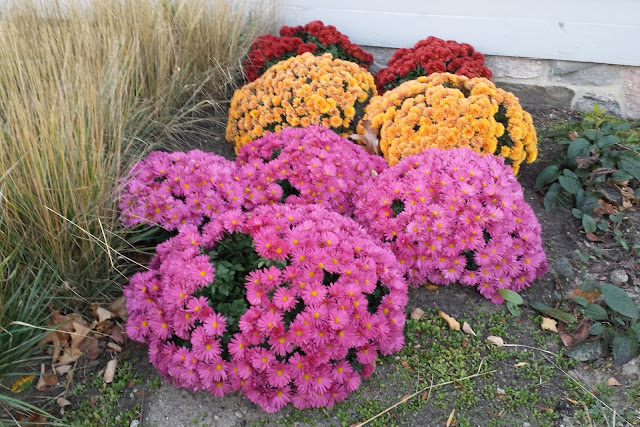We were very excited to have 3 nights in one hotel. That meant we would have a fireplace and jacuzzi for 3 nights. With the forecasted weather being cold, wet, and windy, we would certainly look forward to enjoying those amenities at the end of our days.
Our day's plan was very ambitious. We wanted to go to Henry Ford's Greenfield Village and Edsel Ford's House. We understood that we should expect to spend 4-5 hours to visit the Village.

We set out early to Greenfield Village. We bundled up because the wind chill factor was high. Greenfield Village is a living museum created by Henry Ford. It is like walking back in time to a historical community where visitors become active members who learn by doing. There are streets, cars, horse drawn carriages, a railroad, a church, a post office, a farm, a factory, notable houses and workshops, and much, much more.
Once inside the village, we walked down Main Street and stopped to take in the view. One of the first places we saw was the Richart Wagon Shop. This shop was where the farmers got anything wooden repaired. We went inside to see all of the wooden wagon wheels and tools.


Next, we went to the Soybean Experimental Laboratory. Henry Ford knew soybeans could be used for many things. He built this lab so farmers could experiment with soybeans and other crops. There were various kinds of farming machinery displayed.




Next door was the Armington & Sims Machine Shop and Foundry. This was an incredible place. It represented what a machine shop looked like back in the 1800s, using all authentic machinery which had been relocated to this shop. We looked around at the equipment first.



We, then, had the opportunity to actually use one of the machines to create our very own miniature brass candlesticks. What an experience! We were amazed how the machine we used was so precise. Safety first so Robin had to tuck her hair into her shirt, take off her jacket, and put on the safety googles. Dean didn't have to tuck his hair in, but definitely had to do the other steps. We had a machinist walk us through the steps. At the end, we had to sign certificates of authenticity and were given small candles to use in our candlesticks.





The next place we went was the Edison Illuminating Company's Station A. Henry Ford worked at the Edison Illuminating Company when he built his first car, the Quadricycle. It was really neat to see some of the equipment used by these men as well as seeing the light bulbs.


We saw quite a few Canadian Geese as we walked throughout the village.









Our next adventure was the Artisan area. First we went to the Glass Shop where they were blowing glass into beautiful, fluted bowls. They went through the entire process so we could see how they created the colors and shape of these bowls. Robin really wanted one of these bowls, but later found out they were selling for $285 each. Not this time!







We moved next door to the Gonsolly Carding Mill. We watched the workers clean the wool.



Then we walked to the Printing Office. They did not refer to it as a print "shop" because a printer was considered higher level than someone who worked in a shop.



The Tin Shop came next. We watched the worker craft a duck cookie cutter. The variety of metal items in the shop was incredible.


We left the Tin Shop and headed to the Tripp Sawmill and Stony Creek Sawmill. We saw the steam engine used to run the various operations of the sawmills.

We saw the Weaving Shop, the Pottery Shop and the Loranger Gristmill, but we did not stop. Time was going quickly and we needed to eat lunch.


We headed towards Main Street to check out the only 2 restaurants open during winter. Along the way, we saw many little shops. Many of them looked very interesting, but the mission at the moment was food.



We passed by the Village Pavillion as we made our way to the restaurants.
Finally, we reached the restaurant area. The first restaurant was Eagle Tavern. Costumed servers bring the time period alive with authentic foods of the 19th century. Some examples included pork and apple pie, cornmeal-encrusted trout with caper-taragon butter, and more. These were a little too "foo-foo" for us. We moved on to A Taste of History Restaurant. This was a cafeteria with lots of choice and a cool decor. This was a little more in line with our tastes. We are not real adventurers when it comes to food.









Dr. Howard's Office was next door to the courthouse.
As we walked through the village, we were always on the lookout for the different forms of transportation on the streets.




We went first to the Thomas Edison's Menlo Park Machine Shop. The Edison electric generators were assembled and tested in this building. It became the world's first electric generating plant, supplying power to the laboratory and nearby houses.




The next building was the Menlo Park Laboratory. So many of Edison's accomplishments took place in this building.



Our guide showed us the cupboard under the stairs (small door with handle is the entrance) where Thomas Edison used to hide when bill collectors came to see him. He had a mattress inside the space where he would "wait them out."
We went upstairs and saw the chemical room. There were so many chemicals. The guide upstairs told us the Environmental Protection Agency had come a few years ago and tested the old chemicals. They destroyed many of them because they were dangerous. Notice the lighting.
We moved on to the next building which was the Office and Library.
Thomas Edison was quite the inventor and goal setter. His friendship with Henry Ford allowed many people to get up close to his working environment.
We walked across the street to the Sarah Jordan Boarding House. This had been part of Thomas Edison's Menlo Park Laboratory for unmarried male workers. Edison brought Sarah Jordan, the widow of one of Edison's associates, to Menlo Park to setup and run the boarding house. We loved the outhouse.

Next door was Thomas Edison's Fort Myers Laboratory. It was moved to Greenfield Village from Fort Myers.

From the Edison section of the village, we walked to the Wright Family House. We were pushing for time so did not go inside.

Next door was the Wright Cycle Shop. Inside, there was a wind tunnel, bicycle parts, bicycle tools, model of the Wright Flyer, and many other pieces of equipment.




Across the street was a replica of the original Ford Motor Company. We went inside and saw the huge safe that had been used.


Behind the Ford Motor Company was the depot where we could buy tickets to take a ride in one of the old cars. We waited in line for about 20 minutes and then it was our turn.


Our vehicle was a wagon which was used to haul people and luggage to the train station; thus, the word became station wagon. Our driver drove us all around town. We saw houses of some famous people, such as Noah Webster, Robert Frost, George Washington Carver. There was a Cotswold house and a house with a windmill. We saw a covered bridge with the toll costs posted. As we passed by the Village Green, we saw the Post Office, Town Hall, and the building housing the Herschell-Spillman Company's carousel. It was quite the ride.




When our ride was over, we started to walk back down Main Street towards the exit. We first passed the Firestone Farm. Harvey Firestone, tire maker, was one of the 3 Firestone children raised on this farm. We enjoyed watching the sheep, which were most of the family's livelihood.

There was so much more to do and see at Greenfield Village, but it was almost closing time. We quickly headed to the gift shop at the front. We had briefly looked in the artisan shop, but learned we couldn't afford any of the handmade items. Someone got very silly in the store.


As we left Greenfield Village, we couldn't help but notice all of the beautiful flowers everywhere. There were unique details and buildings to see. We wished we could stay longer. We had already spent 7 hours here, but had only gotten to see about half of what it had to offer. Our plans to see the Edsel Ford House had gone by the wayside about half way through the day as we saw how big the village actually was.


We got back to the hotel and warmed up a little bit. Then we went to Johnny Carino's Italian Restaurant for dinner. Next, it was Starbucks time, followed by Cold Stone. Finally, we headed to CVS to pick up some medicines we had ordered.


Once we got back to the hotel, it was time for a nice warm jacuzzi bath. We warmed up by the fireplace and watched tv until it was time to go to sleep. We had another big day planned for tomorrow.




































































































































